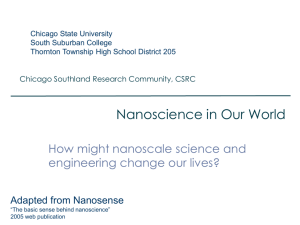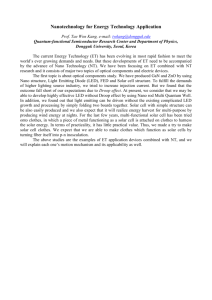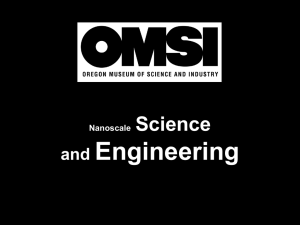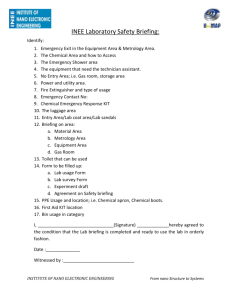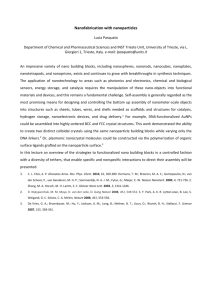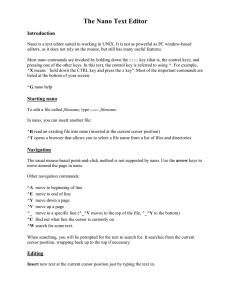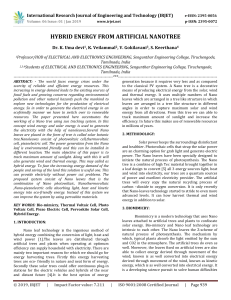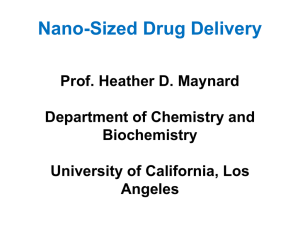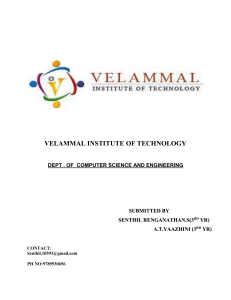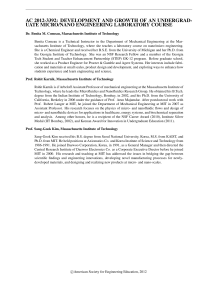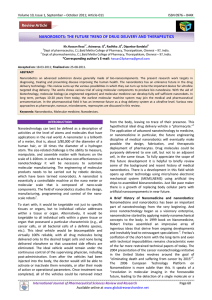Slides - NanoSense
advertisement
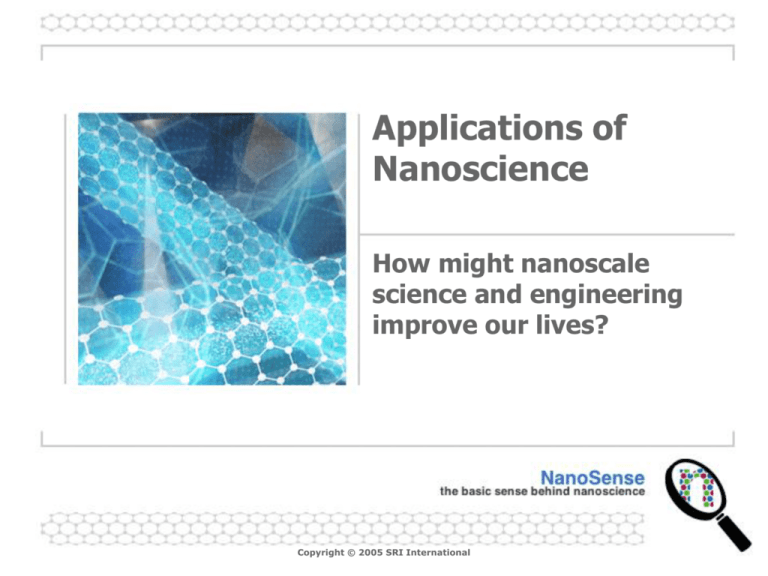
Applications of Nanoscience How might nanoscale science and engineering improve our lives? Copyright © 2005 SRI International 2 Potential Impacts of Nanotechnology • Materials • Technology – Stain-resistant clothes – Better data storage and computation • Health Care – Chemical and biological • Environment sensors, drugs and – Clean energy, clean air delivery devices Thin layers of gold are used in tiny medical devices Carbon nanotubes can be used for H fuel storage Possible entry point for nanomedical device 3 Materials: Stain Resistant Clothes • Nanofibers create cushion of air around fabric – 10 nm carbon whiskers bond with cotton – Acts like peach fuzz; many liquids roll off Nano pants that refuse to stain; Liquids bead up and roll off Nano-Care fabrics with water, cranberry juice, vegetable oil, and mustard after 30 minutes (left) and wiped off with wet paper towel (right) Sources: http://www.sciencentral.com/articles/view.php3?article_id=218391840&cat=3_5 http://mrsec.wisc.edu/Edetc/IPSE/educators/activities/nanoTex.html 4 Materials: Paint That Doesn’t Chip • Protective nanopaint for cars – Water and dirt repellent – Resistant to chipping and scratches – Brighter colors, enhanced gloss – In the future, could change color and selfrepair? Sources: http://www.supanet.com/motoring/testdrives/news/40923/ Mercedes covered with tougher, shinier nanopaint 5 Environment: Paint That Cleans Air • Nanopaint on buildings could reduce pollution – When exposed to ultraviolet light, titanium dioxide (TiO2) nanoparticles in paint break down organic and inorganic pollutants that wash off in the rain – Decompose air pollution particles like formaldehyde Buildings as air purifiers? Sources: http://english.eastday.com/eastday/englishedition/metro/userobject1ai710823.html 6 Environment: Nano Solar Cells • Nano solar cells mixed in plastic could be painted on buses, roofs, clothing – Solar becomes a cheap energy alternative! ] 200 nm Nano solar cell: Inorganic nanorods embedded in semiconducting polymer, sandwiched between two electrodes Source: http://www.berkeley.edu/news/media/releases/2002/03/28_solar.html 7 Technology: A DVD That Could Hold a Million Movies • Current CD and DVD media have storage scale in micrometers • New nanomedia (made when gold self-assembles into strips on silicon) has a storage scale in nanometers – That is 1,000 times more storage along each dimension (length, width)… …or 1,000,000 times greater storage density in total! Source: Images adapted from http://uw.physics.wisc.edu/~himpsel/nano.html 8 Technology: Building Smaller Devices and Chips • Nanolithography to create tiny patterns – Lay down “ink” atom by atom Mona Lisa, 8 microns tall, created by AFM nanolithography Transporting molecules to a surface by dip-pen nanolithography Sources: http://www.ntmdt.ru/SPM-Techniques/Principles/Lithographies/AFM_Oxidation_Lithography_mode37.html http://www.chem.northwestern.edu/~mkngrp/dpn.htm 9 Health Care: Nerve Tissue Talking to Computers • Neuro-electronic networks interface nerve cells with semiconductors – Possible applications in brain research, neurocomputation, prosthetics, biosensors Snail neuron grown on a chip that records the neuron’s activity Source: http://www.biochem.mpg.de/mnphys/publications/05voefro/abstract.html 10 Health Care: Detecting Diseases Earlier • Quantum dots glow in UV light – Injected in mice, collect in tumors – Could locate as few as 10 to 100 cancer cells Quantum Dots: Nanometer-sized crystals that contain free electrons and emit photons when submitted to UV light Sources: http://vortex.tn.tudelft.nl/grkouwen/qdotsite.html http://www.whitaker.org/news/nie2.html Early tumor detection, studied in mice 11 Health Care: Growing Tissue to Repair Hearts • Nanofibers help heart muscle grow in the lab – Filaments ‘instruct’ muscle to grow in orderly way – Before that, fibers grew in random directions Cardiac tissue grown with the help of nanofiber filaments Source: http://www.washington.edu/admin/finmgmt/annrpt/mcdevitt.htm 12 Health Care: Preventing Viruses from Infecting Us • Nanocoatings over proteins on viruses – Could stop viruses from binding to cells – Never get another cold or flu? Gold tethered to the protein shell of a virus Influenza virus: Note proteins on outside that bind to cells Sources: http://www.zephyr.dti.ne.jp/~john8tam/main/Library/influenza_site/influenza_virus.jpg http://pubs.acs.org/cen/topstory/8005/8005notw2.html 13 Health Care: Making Repairs to the Body • Nanorobots are imaginary, but nanosized delivery systems could… – Break apart kidney stones, clear plaque from blood vessels, ferry drugs to tumor cells Source: http://www.genomenewsnetwork.org/articles/2004/08/19/nanorobots.php 14 Pause to Consider How delicate are nanoscale-sized objects? How well do we understand the environmental and health impacts of nanosized clusters of particles? 15 Nanodevices Are Sensitive! • Radiation particles can cause fatal defects – Development requires very clean environments – Redundant copies compensate for high defect rate Pit created by nuclear radiation (an alpha particle) hitting a mica surface Sources: http://www.nanopicoftheday.org/2004Pics/February2004/AlphaRecoil.htm http://www.trnmag.com/Stories/2004/090804/Nano_memory_scheme_handles_defects_Brief_090804.html 16 Potential Risks of Nanotechnology • Health issues – Nanoparticles could be inhaled, swallowed, absorbed through skin, or deliberately injected – Could they trigger inflammation and weaken the immune system? Could they interfere with regulatory mechanisms of enzymes and proteins? • Environmental issues – Nanoparticles could accumulate in soil, water, plants; traditional filters are too big to catch them • New risk assessment methods are needed – National and international agencies are beginning to study the risk; results will lead to new regulations 17 Summary: Science at the Nanoscale • An emerging, interdisciplinary science – Integrates chemistry, physics, biology, materials engineering, earth science, and computer science • The power to collect data and manipulate particles at such a tiny scale will lead to – New areas of research and technology design – Better understanding of matter and interactions – New ways to tackle important problems in healthcare, energy, the environment, and technology – A few practical applications now, but most are years or decades away
